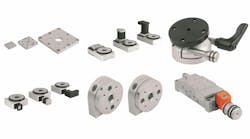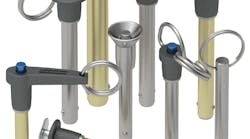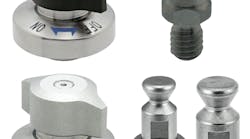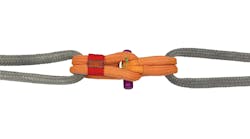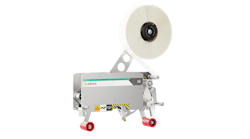First Consideration: Male or Female Anchor
Female anchors
- Require the spotting of the anchor, followed by placement of the fixture over the holes.
- When there is more than one anchor, it may be difficult to get all the holes lined up properly for installation
- Need to have a large hole to be drilled because the hole size is equal to the outside diameter of the anchor
- A more finished look will be achieved from the female type anchor because the head style and type of bolt used will not protrude a far distance from the surface
Male anchors
- Allow the hole to be drilled with the fixture in place
- Fastener to be inserted through the fixture can be fastened directly into the hole drilled into the brick
- Hole size equals anchor size, which means that a smaller hole can be used as compared to the larger hole required for a female type anchor
- A wide variety of head styles is available, depending on the diameter and type of fasteners chosen
Second Consideration: Type of Brick Anchor
Sleeve Anchors are male type anchors that are manufactured in diameters from 1/4 to 3/4 in. and are available in many lengths to accommodate different material thickness.
Sleeve anchors are:
- versatile and can be used in solid brick, brick with holes or the mortar joint
- provide the widest variety of head styles: iround slotted head, flat Phillips countersank, acorn head or the standard hex nut
- Zinc plated sleeve anchors should be used in indoor dry areas: stainless steel sleeve anchors should be considered for use in outside applications
- Come pre-assembled and ready to use
- Hole drilled into the brick is the same diameter as the sleeve anchor being used
Tapcons is the brand name and most wildly recognized name for the self-tapping screw for brick and it is manufactured in the United States.
Tapcons are:
- Available in a hex washer slotted head and a flat Phillips countersunk
- Manufactured in 3/16-in. diameter and 1/4-in. diameter; both diameters come in lengths of 1-1/4, 1-3/4, 2-1/4, 2-3/4, 3-1/4, 3-3/4 and 4 in.; the 1/4-in. diameter also comes in lengths of 5 and 6 in.
- Installed with a hole that must be drilled into the brick before inserting the tapcon screw
- Provide excellent holding values because its threads tap the brick; note that the only problem that may occur when using tapcon in brick is when the very hard abrasive brick is used, the lead threads’ ability to tap the brick may be diminished before the head of the tapcon is tight against the fixture being fastened
- Drilled into the brick using a hole that is slightly smaller in diameter than the diameter of tapcon being installed; a 3/16 in. tapcon requires a 5/32 in. hole and the 1/4 in. tapcon requires a 3/16 in. hole
- Available in the standard blue Climaseal coating or a 410 stainless steel coated with a silver Climaseal coating
Nylon-Nail-its are a light-duty type of brick anchor that has a nylon body with a steel nail. They are:
- Set into the brick by driving the nail with a hammer into the anchor body, and the anchor body expands against the walls of the hole in the brick
- Available in two diameters of 3/16 in. and 1/4 in. and lengths from 3/4 to 3 in. and in three head styles of mushroom head, flat head, and round head. (Note: not all head styles come in both diameters or in all lengths. Some sizes are available with a nylon nail or an aluminum nail.)
- Excellent for use in applications where rust resistance is critical
- A very light duty type anchor that should only be used in applications where the fixture being fastened is not overly heavy
Hammer Drive Anchor – is similar to the nylon nail-it because it works with the same principles. The body of the anchor is made from zinc aluminum magnesium and copper alloy with a steel or stainless steel nail.
The hammer drive anchors are:
- Available with a mushroom head, which is a low profile head that is about 1/2 in. across to provide an excellent bearing surface against the material being fastened
- Relatively soft and pliable, allowing the anchor body to conform to the uneven surface of the hole in the brick
- Not removable once set because the head is configured so that the nail is even with the top surface of the head of the anchor
- Manufactured in two diameters of 3/16 and 1/4 in.; the 3/16 in. diameter hammer set comes in only one length of 3/4 and the 1/4 in. diameter comes in a number of different lengths ranging from 3/4 to 3 in.
Single and Double Expansion Anchors – are female type anchors that accept any bolt with national coarse threads with diameters of 1/4, 3/8, 1/2, 5/8, and 3/4 in.
- The single expansion anchor is used in harder brick and the double expansion is mainly used in brick that may not be of highest quality.
- The single expansion works by a single expansion nut that is pulled up expanding the anchor body against the brick at a single point. The double expansion anchor has two nuts that expand the anchor body along its entire length.
- Both the single and double expansion anchor work well both in the brick or the mortar joint. The only negative aspect of both anchors concerns the diameter of the hole that is required to be drilled in the base material, i.e. the 1/4 in. requires a 1/2 in. hole to be drilled into the brick.
Lag Shields – are available in either a short or long version.
- The short version is for brick that is very dense and hard while the longer version is less dense and softer brick material.
- The extra length of the long lag shield allows for deeper embedment into the brick that creates the potential for better holding values.
- Both lag shields come in diameters of 1/4, 3/8, 1/2, 5/8, 3/4 in. and require the use of a lag screw to expand the anchor once installed into the brick.
- Lag shields can be installed into the brick or the mortar joint and, because the design is versatile, they allow for a wide range of expansion.
- A lag screw must be used to expand the anchor, and lag screws are available only in a hex head.

